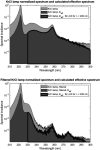Exposure of Human Skin Models to KrCl Excimer Lamps: The Impact of Optical Filtering†
- PMID: 33465817
- PMCID: PMC8247880
- DOI: 10.1111/php.13383
Exposure of Human Skin Models to KrCl Excimer Lamps: The Impact of Optical Filtering†
Abstract
Far-UVC radiation is a promising technology that is potentially both effective at killing airborne microbes such as coronaviruses and influenza, and being minimally hazardous to the skin and eyes. Our previous studies on health risks from far-UVC have employed a krypton-chloride (KrCl) excimer lamp, emitting principally at 222 nm, supplemented with an optical filter to remove longer wavelength emissions inherent to these lamps. This study explores KrCl lamp health hazards by comparing filtered and unfiltered KrCl lamps using effective spectral irradiance calculations and experimental skin exposures. Analysis of effective irradiances showed a notable increase in allowable exposure when using a filter. Induction of DNA dimers (CPD and 6-4PP) was measured in human skin models exposed to a range of radiant exposures up to 500 mJ cm-2 . Compared to sham-exposed tissues, the unfiltered KrCl lamps induced a statistically significant increase in the yield of both DNA lesions at all the radiant exposures studied. Conversely, filtered KrCl lamps do not induce increased levels of dimers at the current daily TLV exposure limit for 222 nm (23 mJ cm-2 ). This work supports the use of filters for far-UVC KrCl excimer lamps when used to limit disease transmission in occupied locations.
© 2021 American Society for Photobiology.
Conflict of interest statement
The authors declare the following pending patent: Patent Title: “Apparatus, method and system for selectively affecting and/or killing a virus”. Applicant: The Trustees of Columbia University in the City of New York. Inventors: Gerhard Randers‐Pehrson, David Jonathan Brenner, Alan Bigelow. Application #: US20180169279A1. Aspect of manuscript covered in patent application: Spectrum filtering elements such as multilayer dielectric filters or chemical filters are used to remove unwanted wavelengths, or those wavelengths that can be outside of the preferable range of wavelengths. URL:
Figures





References
-
- Narita, K. , Asano K., Naito K., Ohashi H., Sasaki M., Morimoto Y., Igarashi T. and Nakane A. (2020) 222‐nm UVC inactivates a wide spectrum of microbial pathogens. J Hosp Infect. 105(3), 459–467. - PubMed
-
- Wang, D. , Oppenländer T., El‐Din M. G. and Bolton J. R. (2010) Comparison of the disinfection effects of vacuum‐UV (VUV) and UV light on Bacillus subtilis spores in aqueous suspensions at 172, 222 and 254 nm. Photochem Photobiol. 86(1), 176–181. - PubMed
-
- Kang, J. W. , Kim S. S. and Kang D. H. (2018) Inactivation dynamics of 222 nm krypton‐chlorine excilamp irradiation on Gram‐positive and Gram‐negative foodborne pathogenic bacteria. Food Res Int. 109, 325–333. - PubMed
-
- Matafonova, G. G. , Batoev V. B., Astakhova S. A., Gómez M. and Christofi N. (2008) Efficiency of KrCl excilamp (222 nm) for inactivation of bacteria in suspension. Lett. Appl. Microbiol. 47(6), 508–513. - PubMed
Publication types
MeSH terms
Substances
Grants and funding
LinkOut - more resources
Full Text Sources
Other Literature Sources

